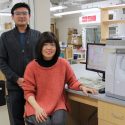Scientists ferret out a key pathway for aging
For decades, scientists have been searching for the fundamental biological secrets of how eating less extends lifespan.
It has been well documented in species ranging from spiders to monkeys that a diet with consistently fewer calories can dramatically slow the process of aging and improve health in old age. But how a reduced diet acts at the most basic level to influence metabolism and physiology to blunt the age-related decline of tissues and cells has remained, for the most part, a mystery.

Now, writing in the current online issue (Nov. 18) of the journal Cell, a team of scientists from the University of Wisconsin–Madison and their colleagues describe a molecular pathway that is a key determinant of the aging process. The finding not only helps explain the cascade of events that contributes to aging, but also provides a rational basis for devising interventions, drugs that may retard aging and contribute to better health in old age.
“We’re getting closer and closer to a good understanding of how caloric restriction works,” says Tomas A. Prolla, a UW–Madison professor of genetics and a senior author of the new Cell study. “This study is the first direct proof for a mechanism underlying the anti-aging effects we observe under caloric restriction.”
The Wisconsin study focuses on an enzyme known as Sirt3, one of a family of enzymes known as sirtuins, which have been implicated in previous studies in the aging process, gene transcription, programmed cell death and stress resistance under reduced calorie conditions. In mammals, including humans, there are seven sirtuins that seem to have wide-ranging influence on cell fate and physiology.
Sirt3 has been less studied than other members of the sirtuin family, but the new study provides “the first clear evidence that sirtuins have anti-aging effects in mammals,” according to John M. Denu of UW–Madison’s Wisconsin Institute for Discovery and a senior author of the report.
The Sirt3 enzyme, Denu explains, acts on mitochondria, structures inside cells that produce energy and that are the sources of highly reactive forms of oxygen known as free radicals, which damage cells and promote the effects of aging. Under reduced-calorie conditions, levels of Sirt3 amp up, altering metabolism and resulting in fewer free radicals produced by mitochondria.
“This is the strongest and most direct link that caloric restriction acts through mitochondria,” says Prolla, who has studied the effects of reduced calorie diets on aging and health for more than a decade. “Sirt3 is playing a surprisingly important role in reprogramming mitochondria to deal with an altered metabolic state under caloric restriction.”
The lead authors of the new study are postdoctoral fellows Shinichi Someya, of UW–Madison and the University of Tokyo, and Wei Yu of UW–Madison. The work involved a mouse model that exhibits age-related hearing loss, a phenomenon associated with free radical damage to the cells of the cochlea, a structure in the inner ear that converts sound vibrations to nerve impulses. Age-related hearing loss is common in humans, and is newly exemplified by such things as ultrasonic cell phone ring tones that only the very young can hear as the cells that capture the highest frequencies are the first to go.
“Hearing loss is associated with the loss of specific cell types in the cochlea,” notes Prolla, whose previous work established a genetic link to cell death and age-related hearing loss. “And hearing loss is prevented through caloric restriction.”
In companion experiments in cultured cells and detailed in the Cell report, the Wisconsin team and their colleagues show that elevated levels of Sirt3 protect cells from cell stress and death caused by free radicals.
“Sirt3 is sufficient to provide protection against oxidative damage,” says Denu.
Although sirtuins have been studied extensively and are believed by many scientists to play a role in aging, the new study is the first to conclusively link the enzymes to slowing the aging process in mammals. According to Denu, who is also a professor of biomolecular chemistry in the UW School of Medicine and Public Health, knowing the molecular basis of how the sirtuin enzymes work may ultimately lead to the rational development of drugs that activate the pathways of enzymes like Sirt3 to slow down the process of aging.
In addition to Denu, Prolla, Yu and Someya, authors of the study include William C. Hallows and James M. Vann of UW–Madison; Jinze Zu and Christiaan Leeuwenburgh of the University of Florida; and Masaru Tanokura of the University of Tokyo. The work was supported by the U.S. National Institutes of Health; the Ministry of Education, Culture, Sports, Science, and Technologies of Japan; and the Marine Bio Foundation.



